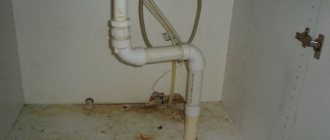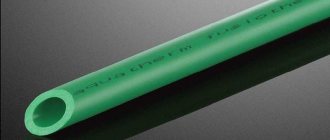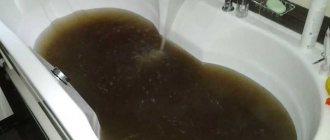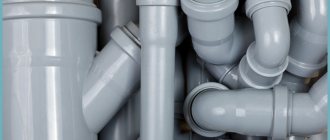Pleasant, refreshing air is an indicator of the cleanliness of the bathroom.
However, in some cases, an irritating sewer odor may appear, which not only causes discomfort, but also poses a health hazard.
Therefore, if alarming signs appear, you should definitely find out and eliminate the cause of the problem, and use preventive measures in the future.
We will tell you in this article how to remove the smell from the bathroom drain.
Why is ambre from the drain dangerous?
The composition of sewage water is rich in ammonia, hydrogen sulfide, methane and other substances that are formed during the decomposition of organic matter. Many of these compounds evaporate and enter the human respiratory tract with the air.
Most gases are poisonous and, if continuously inhaled, cause serious health problems for residents:
anxiety, nervousness;- irritable behavior;
- sleep disturbance;
- rhinitis;
- bronchitis;
- nausea, vomiting;
- migraine;
- dizziness;
- pressure disturbance;
- blurred vision.
Prolonged exposure to persistent sewer vapors can lead to general intoxication and illnesses requiring medical intervention.
Ways to eliminate unpleasant odor from sewers
If there is a smell from the pipes in the bathroom, what to do:
- If the corrugated pipe sag, you should use clamps. They will bring the pipe into its natural position, and this will help remove the unpleasant odor.
- If the bathroom plumbing will not be used for some time, it is recommended to pour a small amount of vegetable oil into the drains. It will create a film that will prevent water evaporation.
- If pipes become depressurized, the joints should be lubricated with sealant.
- If the pipeline is clogged, a plunger or a special cable can help.
Such powders or liquids contain special substances that dissolve contaminants of various origins. After some time, the product is simply washed off with water according to the instructions. These compounds also destroy bacteria in pipes.
You can also use folk remedies:
- Dry mustard powder. It is poured into the hole and filled with boiled water.
- A chlorine solution will also help get rid of the problem, but this substance has a bad effect on the condition of the pipeline.
- You can get rid of blockages in pipes with regular salt. It is poured into the drain and washed off with water after 10 minutes.
- If you pour boiling water over two tablespoons of baking soda, you will get a bubbling solution - you need to pour it down the drain.
These methods are excellent for prevention - to avoid blockages and unpleasant odors from the sewer, it is recommended to clean the pipes using one of these methods once a month.
Causes of unpleasant odor
There are several main reasons why toxic fumes leak from sewers. In each specific case, you should check all possible weak points and, through elimination, find the “root of evil.”
Improper installation of plumbing
The bathtub, sink, and toilet are installed and operated in such a way that all waste flows into the general drainage system. Each plumbing fixture, regardless of its purpose, is equipped with a siphon, which, when filled with water, forms a water seal.
The water in the bend of the siphon does not allow the putrid smell from the sewer to enter the room. If the siphon level is too low, then there is a high probability of a water seal failure.
When purchasing plumbing fixtures, it is recommended to choose items with a deep siphon and a large volume (at least 300 ml).
Errors in designing a drainage system
Proper installation of pipes and plumbing requires the presence of a drain pipe through which the sewer riser is connected to the ventilation passage. The latter is displayed on the roof of the building.
The consequence of improper installation or clogging of the drain pipe is the entry of air bubbles into the drainage riser through the siphon or pipe joints. As a result, the water seal “goes” into the sewer riser, and the barrier to the gases disappears.
Other reasons associated with the design and installation of a drainage system include:
- Failure to comply with the slope of the sewer pipe.
- Inaccurately selected pipe diameter.
- The assembly of the structure does not start from the bottom position.
Blockages
They are among the most common causes of foul odor. Small debris, wool, and hair regularly fall into the drain. Accumulating in the channel, they impede the flow of fluid.
Soon the resulting organic plug begins to decompose and create an unpleasant odor.
The situation gets worse if a large object gets into the pipe . It creates a barrier to the drainage and collects all small debris.
Icing during the cold season can lead to stagnation of wastewater in the pipeline.
Leaks
Much depends on the degree of soldering of pipe joints. If depressurization occurs and gaps appear at the joints, then the appearance of liquid waste in the bathroom is guaranteed. They help maintain odor and dirt.
Old metal pipes lead to the same problem . Rust eats through the metal, causing a gap or perforation to form. Liquid begins to seep through these holes.
Large accidents are easy to spot because they create visible puddles. Small leaks are more difficult to find and require a more thorough inspection of the system.
Deterioration of ventilation
The plumbing room must have a ventilation outlet. If it is missing or clogged, odors and water vapor accumulate in the bathroom.
This contributes not only to the accumulation of gases in a confined space, but also to the development of pathogenic fungi.
Air stagnation in a small room can result from:
- Clogged ventilation shaft in the house.
- Forced air flow from neighboring apartments.
Problems with siphon and water seal
The main problems associated with improper operation of the water seal and siphon are:
- Noticeable sagging of the corrugated pipe. The material from which the corrugation is made means that over time the product will lose its elasticity and other qualities, which is why problems will certainly arise in the future. This does not depend on the quality of the pipe - any corrugated products will begin to sag over time. This is inevitable, and sooner or later the corrugation will have to be replaced.
- If the siphon was installed incorrectly, difficulties may also arise during operation. This problem is often encountered by those who decide to carry out sewer work on their own, without the help of professional plumbers. This is due to the fact that installing a siphon requires compliance with certain rules, and the slightest mistakes can lead to problems.
- It is recommended to listen to the sounds of water flowing down the drain. An incomprehensible rustling or gurgling sound is a sign of a broken water seal. This indicates that there is no water in the device, which prevents odors from the sewer from entering the house. In addition, a vacuum plug may form in the riser. Therefore, if you suspect a malfunction of the water seal, you should take immediate action - if you do not fix the problem with the siphon, the smell from the sewer pipe in the bathroom will constantly come out. Read also: “How to clean pipes at home and what is best to use for this.”
How to find the source of the problem?
To calculate the cause, you need to sequentially check all possible points of problems. These include:
- Checking the ventilation system. A piece of paper or a lit match is applied to the hood grille. The deflection of the paper and flame towards the shaft indicates good air outflow.
- Search for leaks. Use a clean napkin to guide the sewer pipes. Particular attention is paid to the joints. Finding wet dirt indicates cracks or gaps.
- Determining the position of the sewer pipe. To do this, use a building level. It will show whether the required slope is available.
- Checking the drain. Testing is carried out by opening the water taps as much as possible. Stagnant or slow flow of water from a sink or bathtub indicates a blockage.
How to deal with bathroom odor
Once the cause of the stench has been established, measures can be taken to eliminate it. If we are talking about an apartment building and the problems, for example, a blockage, are in the general building drainage system, then it is necessary to involve employees from the management organization.
If faults are localized inside an apartment or in a private house, you need to remove them yourself or with the help of hired specialists.
- If it is discovered that the sewer system was installed with violations, then it will be necessary to completely redo it or make changes to some areas. To do this, it is better to call an experienced plumber.
- Leaks often occur at joints. The pipelines must be disconnected and reconnected and sealed. If the leak occurs due to a violation of the integrity of the pipe, then it is necessary to seal the crack and subsequently replace the damaged area.
- The accumulation of condensate on the pipe due to temperature differences is prevented by insulation.
- The operation of the siphon can be restored in various ways, the choice of which depends on the cause. This could be clearing a blockage, eliminating sagging corrugations using clamps, pouring hot water into a pipe to defrost ice, or restoring the permeability of a ventilation pipe.
- Air ventilation cleaning is carried out by a specialist. If movement is free, but moisture removal is not enough, then you can install a grille with a fan that removes air forcibly.
- When the stench comes from the washing machine, it is necessary to run a dry wash in the boiling mode with detergent. After this, thoroughly wipe the drum and cuff. Another measure is to clean the drain pump and hose.
- Blockages in sewer pipelines are eliminated using special means and cables. There are even electric pipe cleaners used by professionals.
The main causes of stench in the bathroom are blockages and leaks in pipes, as well as problems with sewer ventilation and siphons.
You can troubleshoot problems yourself or with the help of specialists. But prevention, which includes several measures, is much more effective.
When installing sewer systems, it is necessary to avoid a large number of joints and turns and place them in accessible places. It is important to use pipelines and fittings of the correct diameter, high quality and observe the slope during installation.
Do not throw construction waste, rags or other waste into the sewer that will cause pollution. It is worth regularly cleaning the siphon and sewer pipes. It is recommended to install grease traps after kitchen sinks and dishwashers. If the pipeline runs in places where there is a temperature difference, then it needs to be insulated. Entrust the installation of the entire sewer network to professionals. If you have to leave your home for a long time, it is recommended to pour a little vegetable oil into the siphons, which will prevent the evaporation of the liquid.
Following these simple rules will help prevent the occurrence of odor.
How to fix it?
The solution to the issue depends on what caused the smell. Each specific case requires the use of your own skills, special tools or calling a specialist.
Improved traction
You can improve ventilation in the bathroom in different ways, for this:
install a fan on the hood, selecting it according to the volume of the bathroom;- install an axial or duct fan with a check valve on the ceiling;
- open the bathroom door at night to remove the air lock in the ventilation duct;
- make holes in the door leaf for more efficient air circulation around the room;
- using a hook and a flashlight, they remove fallen objects or debris from the shaft.
When the natural air circulation in the bathroom is disrupted, it is necessary to install forced ventilation.
Pipe cleaning
If the smell appears due to clogged pipes or siphon, use a suitable cleaning method. There are three main methods.
- Chemical. The range of household chemicals offers powder, gel, granular products. The most popular are Mole, Mister Muscle, Bagi Pothan, HAAH, Chirton, PROSEPT and others.
- People's To dissolve small traffic jams, use available means (soda, vinegar, citric acid). A strong solution is poured into the drain hole and left for 20 minutes. Then rinse with tap water.
- Mechanical. You can clear a clogged pipe bend under the sink using a plunger or manually by unscrewing the siphon. A distant blockage is removed using a cable. It is lowered into the drain hole and pushed through the pipe with rotational movements.
A metal cable cannot be used to clean plastic sewers; it can damage the walls of the siphon and the pipes themselves.
Repairing leaks
Detected cracks in the pipes are sealed using fum tape or a special sealant. The latter method is considered more reliable.
For plumbing repairs, various sealing materials are used:
- silicone;
- acrylic;
- silicone acrylic;
- polyurethane.
Before applying sealant to the pipe, its surface is cleaned, degreased and dried. The mastic is distributed with a spatula, making a continuous circular line. You can use plumbing fixtures after the product has completely dried.
Correcting installation errors
This work is the most difficult, and it is not always possible to carry it out on your own .
If the problem is caused by the lack of slope of the sewer pipe, then sometimes it is possible to place a small block or brick under the near end of the pipeline. The desired slope is created, and the waste naturally goes into the sewer.
Possible installation errors
Errors during the installation of siphons can be as follows:
- The pipe is not immersed in the water correctly. This oversight is very common, because of this, an unpleasant aroma penetrates the room through the space between the walls of the siphon and the water.
- Tension when installing corrugated pipe. Plumbers who are not particularly skilled can also commit negligence.
- Shortened siphon partition. This causes the water seal to be too small, it periodically breaks and the water escapes. There is only one way to solve this problem - replace the siphon.
- The corrugated pipe was bent. In such a situation, you can bring it to its normal position and secure it with electrical tape. But this is only a temporary measure; in the future you need to buy a new pipe.
- Incorrect installation of the siphon (for example, upside down).
- Lack of plumbing maintenance. Prolonged stagnation of water can cause evaporation of water stagnant in the siphon. Namely, this liquid, which is constantly present in the device, does not allow bad odors to penetrate into the room from the sewer.
These situations are usually the main reasons for the formation of an unpleasant odor. Contamination of pipes can occur even during short-term operation of the pipeline. In these situations, not only a slight coating forms on it, but also real traces of rot and mold in the system, as well as various manifestations of bacterial activity.
An unpleasant smell from pipes in the bathroom can also occur if the diameter of the riser is too small. According to standards, it must be at least 11 centimeters. If this value is less, the passage of drains may be difficult, and this will cause blockages, which, in turn, will lead to the appearance of an unpleasant odor.
In this situation, replacing pipes with products with a larger diameter should be done by professionals who can do the job correctly. Trying to solve a problem on your own often leads to an even worse situation.
In what cases should you call a specialist?
Special situations require the intervention of a specialist. A professional, having experience and a special tool, will be able to fix the problem at a professional level.
It is necessary to contact specialists if:
- It is not possible to clean the ventilation shaft on your own;
- it is difficult to replace an old, unusable sewer pipe;
- Incorrect installation of a plumbing fixture needs to be corrected;
- install forced ventilation in the bathroom;
- remove hard-to-reach blockage at the distal end of the pipe.
The cost of the service depends on the specifics of the problem, the volume and complexity of the work, and the price list of a particular workshop. Calling a specialist can cost the owner from 500 to 5000 rubles.
How to deal with unpleasant odor
Let's look at how to eliminate sewer smell in a shower stall. There are three options to resolve the issue:
- installation of a deeper siphon with an increased water seal;
- installation of a sewer valve;
- restoration of the drain pipe.
First of all, you need to find out exactly why the shower smells like sewer and what to do to fix the problem. It is necessary to check the condition of all system components:
- inspect the shower siphon. If it is too small (or absent altogether), you need to purchase a new, more efficient one. At the same time, you need to measure the distance from the outlet to the floor so as not to buy an element that is too large;
- The sewer valve can be installed on the existing system directly in the apartment. To do this, you need to insert an outlet into the pipe gap to which the valve is connected. It must be borne in mind that it can only solve the issue at low pressure in the system. If it is excessive, gas from the sewer will still flow into the apartment;
- restore the condition of the drain pipe. Here the issue can only be resolved with the help of the management company’s employees. The riser is a common property of the house; unauthorized interference with its operation is not allowed.
Installing a new siphon or sewer valve is not very difficult and can be done with your own hands. In addition, it is useful to periodically carry out preventive maintenance of the drain fittings. It is necessary to clean it of residual fat, hair and other deposits. They decompose and also emit an unpleasant odor. For cleaning, various compositions are used that are sold in hardware stores.
Prevention measures
Even if your bathroom drainage system is not a concern, it is important to remember and implement preventive techniques. They will provide fresh air in the room and protect the owner from unexpected expenses.
Experts recommend:
Install small screens on the sink and bathtub drains that will trap debris and dirt.- When changing plumbing fixtures, replace old pipes at the same time.
- Periodically rinse the drain coming from the sink and bathtub with boiling water.
- After 1-2 months, flush the pipes with special chemicals or a homemade composition.
- Every six months, check the condition of ventilation and sewerage.
Why is the water seal broken?
There may be several reasons for this phenomenon, so it is important to consider each case separately:
- The most common reason is improper installation of the siphon. If an ordinary product is installed that looks like a flask, where the pipe is not provided for lowering into the water inside the siphon, then most likely there will still be an unpleasant odor. It easily passes between the water and the walls of the device, thus freely entering the room. To prevent such a situation and make the water retain unpleasant odors again, you just need to lower the pipe into the water a few centimeters lower. Only it should not fall so that it rests against the bottom of the siphon.
- The problem may arise due to sagging of the corrugated tube. If you bend the elbow correctly, the corrugated tube will retain a certain amount of water at the lower level. As a result, the required water seal will be created in the system. After some time, the corrugation loses its rigidity and begins to sag, as a result of which the water level decreases and the water seal disappears. To prevent this situation, you can use special clamps that hold the tube in the correct position for a long time. You can also use regular electrical tape, which can be used to tie the tube as it should be.
- Often an unpleasant odor occurs due to fumes emanating from the siphon. As a rule, this happens due to long downtime of sewerage devices. If the system is not used, the water from the siphon will simply evaporate, and the water seal will break. Many owners of houses and apartments are interested in how to remove this smell and what measures can be taken to prevent this situation? Everything is much simpler than it seems at first glance. Before a long trip, it is recommended to pour a little vegetable oil into the drain hole of the plumbing fixture. Thus, due to the formation of a special film, water will not evaporate from the siphon. If such an incident could not be avoided, then you just need to drain more water to flush the siphon that has accumulated sewer odor.
- Installation errors or savings can also cause unpleasant odors. Illiterate professionals can overstretch the corrugated pipe or secure it in the wrong condition, which will result in a broken or missing water seal. In such situations, a bad smell appears immediately after the installation of new plumbing fixtures.
Additional Tips
To protect yourself from the problem of unpleasant odor in the bathroom, you should listen to the following recommendations:
- Entrust the development of the project and installation of the home drainage system to experienced professionals.
- When choosing a sealant for sealing cracks, it is advisable to give preference to compounds that contain antibacterial and fungicidal additives.
- In summer, without use, the siphon quickly dries out; to restore the hygienic condition of the bathroom, just pour water into it.
All the most important and useful information about cleaning the bathroom is collected in this section of the site.
Options for solving the problem
Correcting the situation with pipes in a timely manner will freshen the air not only in the bathroom, but throughout the entire house. There is no point in escalating the problem, as it can have a negative impact on the health of your household.
Improved traction
There are several ways to get rid of bad smell in the bathroom by increasing the draft of the ventilation system:
- Blockages in the shaft are removed using an installed fan. It turns on automatically, spraying particles of dust and dirt.
- The air lock in the ventilation is removed by opening the bathroom doors at night.
- Objects that fall into the shaft are lifted with a special device, shining a flashlight.
- The axial model fan is installed on the ceiling.
- Holes are made at the bottom of the door to allow air to circulate in the bathroom.
See also
TOP 20 remedies for removing unpleasant odor from a sofa at home
These actions are often enough to remove unpleasant odors.
Cleaning
Sewer clogs can be removed in different ways. Either special devices or chemical concentrates should be used. Sometimes you can get by with simple means.
Mechanical
To remove blockages in bathroom pipes, you need a plunger. They close the drain hole. Then fill the bathtub or sink with water so that it covers the bottom of the plunger cap. Then move the elastic cap up and down.
If after the procedure the water begins to flow quickly, then the blockage has been eliminated. Otherwise, repeat the operation several times.
For metal pipes, cleaning with a cable will be effective. Pass the metal product inside the hole and push it further with clockwise rotational movements. A cable can be used to remove the plug from debris and dirt. After this, hot water is poured into the hole to break down the fatty deposits in the pipes. The cable is washed with soapy water, wiped dry, lubricated with machine oil and stored in a dry place.
If there are no devices at hand, then unscrew the siphon or pipe, remove the stuck debris, and wash with soapy water.
Folk remedies
Odors of ammonia and mold are removed from sewer pipes in the bathroom using improvised means. Every housewife has substances that can remove blockages in pipes.
Salt
Place 3 tablespoons of salt in a glass of hot water. Pour the solution into the bathtub hole and leave overnight. You can pour salt into the drain and pour boiling water on top.
Soda and vinegar
A mixture of baking soda and acetic acid can help eliminate stench caused by clogs in your drainage system. The substances break down layers of dirt and grease on the inside of pipes. They are taken in equal quantities and the pulp is placed in the drain. Then pour hot water. After 2-3 hours, a fresh smell appears in the room.
"Alka-Seltzer"
Anti-hangover tablets work well in clearing clogged pipes. Throw 2 tablets of the drug into the hole in the bathtub or sink. A glass of vinegar is poured in there. Rinse with a stream of water after 5 minutes.
Mustard
For strong odors in the bathroom, you can use mustard powder. Pour the substance into the drain, and then hot water on top. Within 10 minutes the water drainage will be restored.
"White"
Chlorine-containing liquid is suitable for combating blockages in the sewer system. You need to pour the solution into the hole. After 20 minutes - hot water. And the smell will disappear, the drain will work quickly.
Professional products
When improvised means cannot cope with cleaning pipes, then strong concentrates come to the rescue. They are based on acids and alkaline compounds that break down pollution.
"Domestos"
The product is used not only for cleaning tile products, but also for gutters and drains. As part of Domestos:
- sodium hypochlorite, which disinfects and degreases surfaces inside pipes;
- Surfactants that help the product dissolve better;
- soap for disinfection;
- fragrances that muffle unpleasant odors.
Dilute 50 ml of the product in 5 liters of water or use undiluted.
See also
50 best remedies and methods for removing unpleasant odors from the refrigerator
"Mole"
One of the best clog removers consists of sodium and potassium hydroxide. The filler is a chemical acid. Krota substances can dissolve and break down any deposits in pipes. Pour 200 ml of cleaning liquid into the drain hole. If powder is used, then it is poured and filled with hot water in the amount of 2 glasses. After 1.5-2 hours the product will take effect. All that remains is to flush the system with water.
"Tiret"
A concentrated liquid with a pungent odor quickly cleans plumbing drains. 250 ml of product is poured into the pipe. After 5-15 minutes, repeat the procedure, taking 100 ml of thick gel. Then pour 2 liters of hot water into the sink. After this procedure, the blockage will disappear. Cleaning is carried out wearing rubber gloves, protecting the respiratory system with a mask and eyes with goggles.
"Steril"
The disinfectant is a white powder. The working solution is prepared at 1 or 2% before the sewer cleaning procedure. It is poured into the sink hole and left for half an hour. Finally, rinse with warm water.
"Pothan"
The chemical is used to clean plumbing pipes. Since the substance emits dangerous gases, safety precautions should be followed when using the product. It contains about 30% caustic alkali.
The advantage of the drug is its effectiveness and rapid action. In just 3 minutes the blockage will be cleared.
"Mister Muscle"
Get rid of hair and dirt, remove unpleasant odors - the drug can do all this. Foam or gel is poured into the pipes, then the system is washed with warm water. It is necessary to work with gloves, trying to prevent the liquid from getting on the skin.











